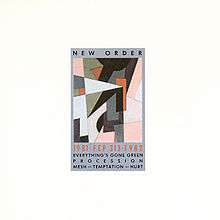1981–1982 (EP)
| 1981–1982 | ||||
|---|---|---|---|---|
 | ||||
| EP by New Order | ||||
| Released | November 1982 | |||
| Recorded | 1981–1982 | |||
| Genre | Post-punk, alternative rock, new wave | |||
| Length | 29:49 | |||
| Label | Factory Records | |||
| Producer |
Martin Hannett New Order | |||
| New Order chronology | ||||
| ||||
| Professional ratings | |
|---|---|
| Review scores | |
| Source | Rating |
| Allmusic | |
| Robert Christgau | B+[2] |
1981–1982, also often known by its catalog number "Factus 8", or "1981-Factus 8-1982", is a five-track EP released by New Order in November 1982 by Factory.
Overview
1981–1982 or "Factus 8" was put together for the American market as a compilation of three of New Order's early singles. It contains "Procession" from September 1981, plus the 12" versions of "Everything's Gone Green" (released December 1981) and "Temptation" (released May 1982) and two of the b-sides, "Mesh" and "Hurt". A second b-side to "Everything's Gone Green", "Cries and Whispers" is omitted, as is New Order's first single "Ceremony" / "In a Lonely Place". The sleeve was designed by Peter Saville and uses a painting from his then-girlfriend Martha Ladly.
The songs of this era—in particular this version of "Temptation"—signaled a critical turning point in the development of New Order as the group shifted from simply being the remnants of Joy Division after the suicide of lead singer Ian Curtis to being a singular band in its own right. The EP is frequently viewed as a bridge from the group's Joy Division-like debut album, Movement, to the new electronic-based sound contained on its second album, Power, Corruption & Lies.
The Village Voice music critic Robert Christgau described this version of "Temptation" as being "where Manchester's finest stop hearing ghosts and stake their claim to a danceable pop of unprecedented grimness and power," noting that it was "the first real song this sharp-cornered sound-and-groove band has ever come up with."[2]
The EP also documents the band's break from producer Martin Hannett, who had produced Movement and both of Joy Division's studio albums. While Hannett produced "Everything's Gone Green", "Procession" and "Mesh", the other two songs on the EP were produced by New Order. Bernard Sumner remarked: "Martin's last track was "Everything's Gone Green" – fact he walked out halfway through the mix because Hooky and me asked him to turn the drums up".[3]
Reissue of EP tracks
All of the tracks from 1981–1982 were eventually re-released on the bonus CD in the 2008 Collector's Edition of Movement, along with other tracks from the same period.
Track listing
all writing Gillian Gilbert, Peter Hook, Stephen Morris, Bernard Sumner
Side One
- "Everything's Gone Green" – 5:30
- "Procession" – 4:27
- "Mesh" – 3:02
Side Two
- "Temptation" – 8:47
- "Hurt" – 8:03
Personnel
- Bernard Sumner: Vocals, guitars, melodica, synthesisers & programming
- Peter Hook: 4- and 6-stringed bass
- Gillian Gilbert: Synthesizers and programming, guitars
- Stephen Morris: Drums, synthesisers and programming
- Martin Hannett: Production ("Everything's Gone Green", "Procession" and "Mesh")
- Chris Nagle: Engineering
- John and Flood: Assistants
Chart positions
| Chart (1983/4) | Peak position |
|---|---|
| New Zealand RIANZ Album Chart[4] | 4 |
| U.K. Independent Albums Chart[5] | 4 |
References
- ↑ Ruhlmann, William. "Review: 1981 – 1982 – New Order". Allmusic. Retrieved 28 June 2010.
- 1 2 "Robert Christgau, Consumer Guide Review: New Order – 1981–1982". robertchristgau.com. Retrieved 21 May 2010.
- ↑ Nolan, David (2007). Bernard Sumner – Confusion (1st ed.). Church Stretton: Independent Music Press. p. 102. ISBN 0-9552822-6-8.
- ↑ "Discography New Order". Charts.ord.nz. Retrieved 23 February 2011.
- ↑ "Indie Hits "N"". Cherry Red Records. Retrieved 2 Oct 2008.